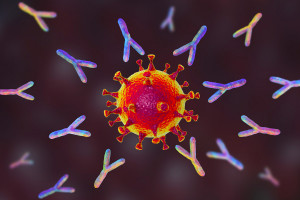I Love My Job: Why Bartram’s Garden ED Maitreyi Roy Is Optimistic in the Face of Climate Change
The leader says the oasis is still a refuge where people can “recoup their energies and restore their spirits.” Here's how she keeps it that way.
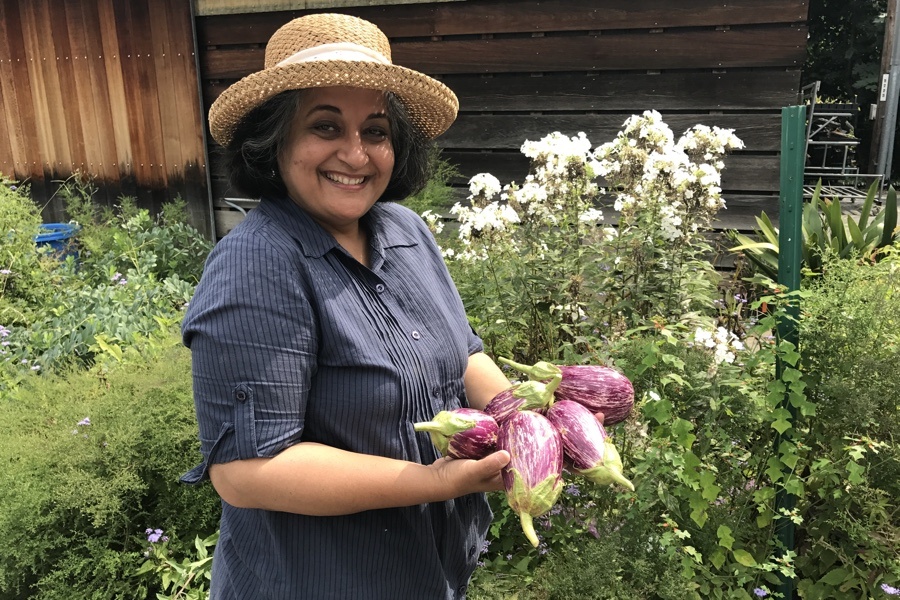
Bartram’s Garden executive director Maitreyi Roy. Courtesy photo.
Bartram’s Garden remains one of Philadelphia’s greatest hidden gems. The 45-acre stretch of land on the Schuylkill River’s west bank is the oldest surviving botanic garden on the continent, and its executive director — the sagacious and optimistic Maitreyi Roy — says the age of the landmark is an opportunity to make sure it thrives as a resource for Philadelphia’s Southwest community and beyond. Roy feels a huge responsibility to keep things growing in the face of challenges like extreme weather. But she says the biggest threat to the garden is not listening to the desires of its surrounding community. In the years Roy has been in the role, she’s focused on changing perceptions about who’s allowed in the space, through efforts like the Sankofa Community Farm. Here’s why Roy says she really, truly loves her job and didn’t have to make any of the following answers up:
I grew up in… the south of India, in a place called Mysuru. It’s a beautiful university town. I had a wonderful childhood there, with rice fields and big trees all around us. It was truly a paradise like setting.
I came to the States when… I was around 25. My husband and I decided to go to graduate school in Cambridge, Massachusetts in the Boston area. We’ve lived in the States ever since and moved to Philadelphia in 1993. We fell in love with this amazing city.
A fond childhood memory… is when I would steal away from my chores and get a book. There was a big guava tree in our backyard, and I would find a shady spot underneath it where I could read. I was a bookworm.
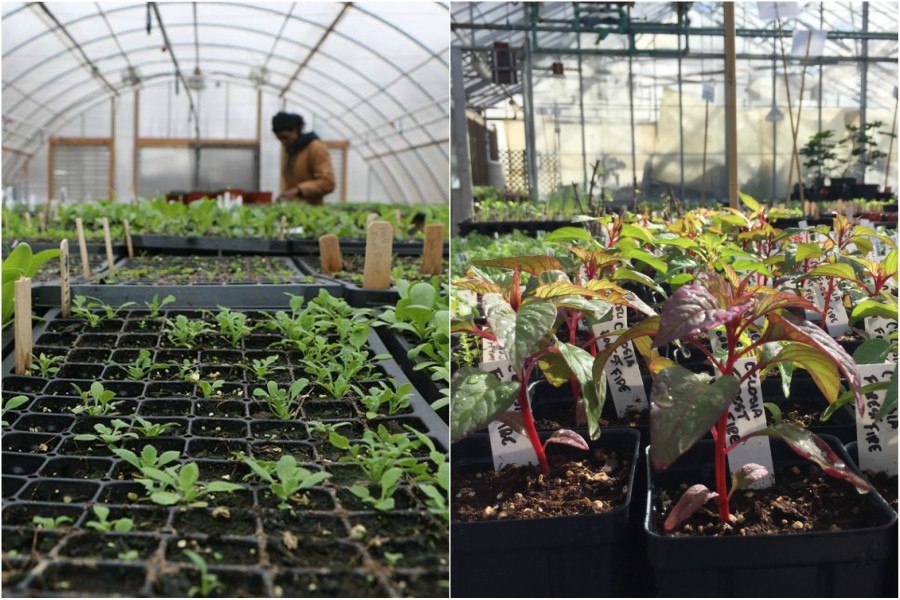
Bartram’s Garden greenhouse.
My favorite thing to grow in a garden… definitely changes, but right now, it’s Sun Gold cherry tomatoes. They’re so good! They’re tiny little yellow cherry tomatoes and when you pop them in your mouth the sweetness just explodes. It’s like candy. So good!
I studied landscape architecture because… when I was going through architecture school — I’m trained as an architect — I realized what I really wanted to do was work on the spaces in between buildings, in the public realm. I wanted to explore that in my landscape architectural coursework. I was intrigued by how what you do with land can have a big impact on how a community’s life unfolds. That was at the heart of it. Much like I have the privilege to do at Bartram’s now. I have the opportunity to give this garden a new life and shape.

The view from Bartram’s Garden at sunset.
People typically fall in love with Bartram’s Garden when… they realize our city isn’t all urban jungle, that it’s not all concrete and about streets and congestion and traffic. We have this incredible oasis in the city, a place where you can connect to nature without leaving the city. People realize they can build nature into their daily lives when they make Bartram’s their own backyard.
My favorite places to go in the city outside of the garden… are down by the Wissahickon Creek—I live in Mt. Airy. I love it down there. It’s so beautiful. I also like going to places where there’s a lot of hustle and bustle like Reading Terminal Market. I love going to the Italian Market on weekend mornings. I love the contrast of spaces that are so beautiful like an oasis or refuge, and they’re teeming with life.
When I first got here, people in the community didn’t feel welcome in the garden because… the perception was that people weren’t welcome there even though the gates were open. People thought it was more of an enclave for horticulturists or something. In the last few years, we’ve made a lot of effort to invite people in. We’ve gone to schools and churches to invite people to come and use the garden as part of their lives. Things have started to turn around. People really need to feel and see themselves in the garden. It’s changing because we’re working hard and putting that invitation out.
The Sankofa Community Farm is a place where… Southwest families and children can come and connect with the land. They can get their hands in the soil. They can share their culture and history by growing plants that they’re familiar with and care about. And they get to know each other through food. In Twi, “Sankofa” means, “go back and get it.” We emphasize that learning about the past can really help us in doing the work to ensure a healthy, sustainable future.
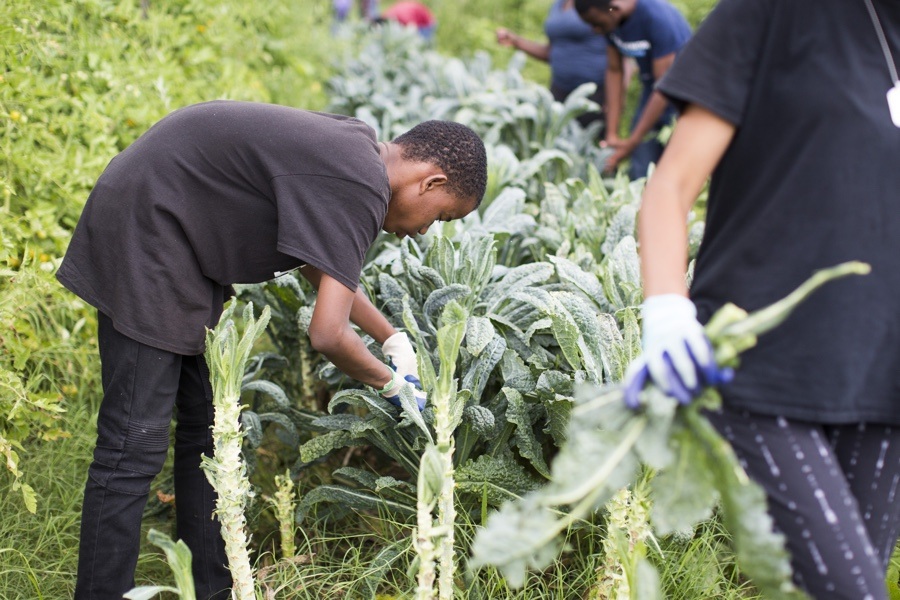
Sankofa Community Garden.
The biggest threat to the garden is… not listening to community to find out what they aspire to be and desire to be. That’s the biggest challenge.
Bartram’s garden is sometimes called “a place with potential” because… nature is filled with potential. This idea that the earth is productive. And our river is a life source because that’s where our drinking water comes from. There’s fresh air to be had. In some way, we as human beings find our own potential when we interact with nature. That’s why this garden is filled with potential because it helps unlock human potential.

Biking at Bartram’s Garden. Courtesy photo.
My favorite part of the garden is… wherever there are groups of children. Whenever I see them, there’s laughter and shrieks because they see something like the turkeys or a snake. I love to see how they explore. It’s their grand adventure.
The hidden gems of the garden are… some very special places and things. For instance, there’s secret beach along the riverfront that’s only visible when it’s low tide. There are turkeys and foxes here that show up when you’re walking around. And there’s an incredible collection of historic trees that you wouldn’t see anywhere else.
The Comcast MachineQ team just installed sensors in the garden to… monitor the soil conditions for our historic plant collection, some of which goes back to 1784.
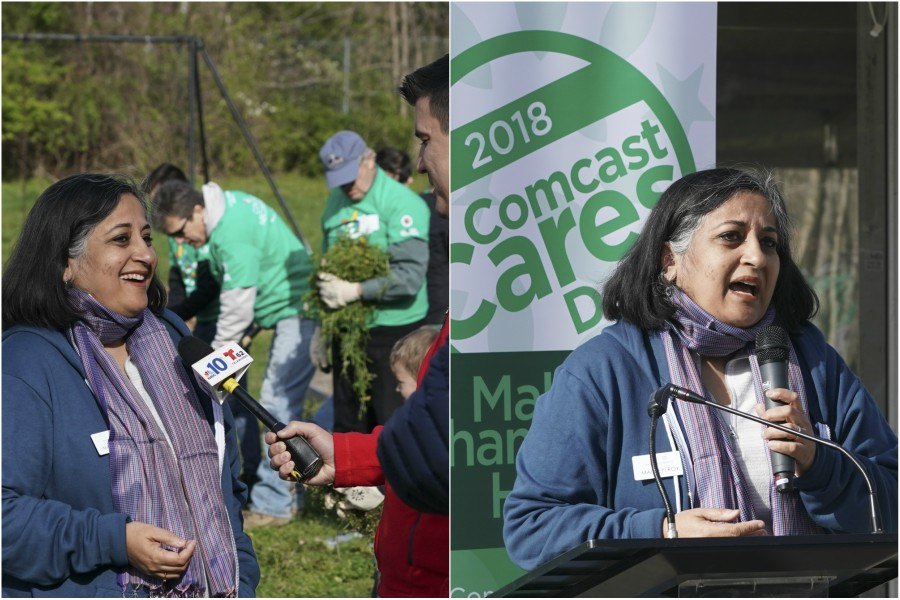
Comcast Cares Day. Photos courtesy of Comcast.
The recent Comcast Cares Day event… brought over 300 volunteers to the garden. They helped us build the most incredible compost center, which will now allow us to provide compost to people in the community. They helped us really reawaken the whole garden for spring.
To those of you who have never been to the garden, when you do come I suggest that you… come on a Saturday morning when we offer free paddles on the Schuylkill. Come enjoy a kayak or canoe ride. Then go to the Welcome Center to see what else we have. Just open your heart and our farm and garden will welcome you.
Since 2012, I’ve focused my leadership on… building a shared vision to make this garden a great civic common so we can really celebrate a rich community life and make this garden a place where people can find beauty and joy. In times when there’s so much division and hate, it can be a refuge for people from all walks of life. So I’ve focused on collaboration, partnerships and building relationships.

Maitreyi Roy at the garden. Courtesy photo.
Climate change is affecting our work and schedule by… making us do more to manage the extreme weather conditions we’re facing. We’re lucky in that the garden’s geography is such that there are many microclimates here. But with the big storms, trees come down. We’ve had flash floods that have eroded our riverbanks. In the summer, with the drought, we have to pay attention to water to make sure there is enough for plants. We’ve had to be much more vigilant about what the conditions are in each part of the garden.
Something I’m looking forward to this summer is… becoming a grandmother in September!
The trail expansion is important because… the Southwest community, unlike any other neighborhood in city, doesn’t have that connection to the city’s park system. One of the most beautiful things about Philadelphia is this extraordinary Fairmount Park, which runs right through the city and every neighborhood has a connection to it. The Southwest has never had that. It’s so important for the city and region to discover us. But even more important, the Southwest community can find its connection to the city’s park system, to Center City, to jobs, to health and recreation opportunities. It opens up many possibilities for the Southwest community.
My favorite meal is… when I cook with the interns at the farm. We harvest that morning from the farm to see what veggies are ready. We come up with a menu and make a meal. I love to put Indian spices in the dishes. We share the meal with the whole class right there. We take what we grow and make it a wonderful meal, so it’s directly from farm to belly.
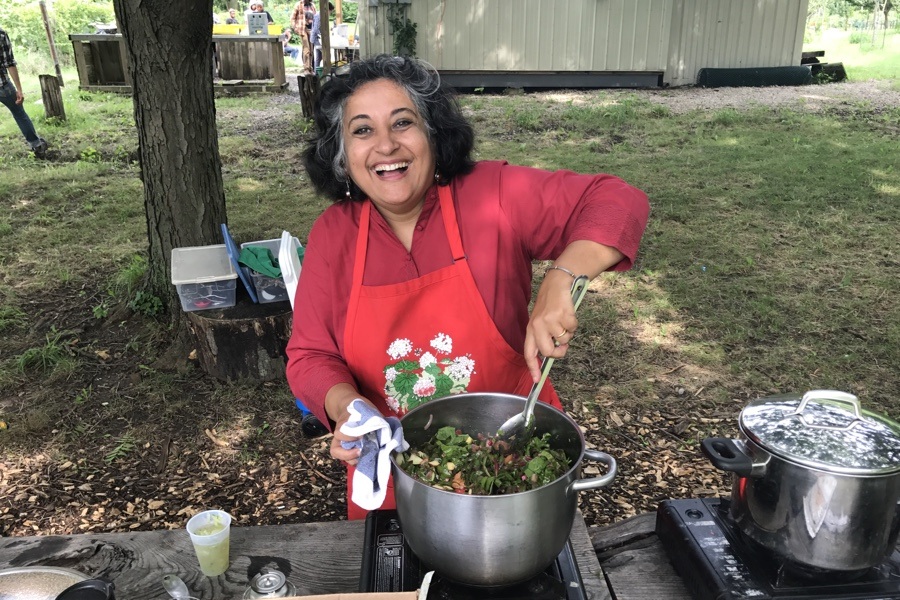
Maitreyi Roy cooking at Bartram’s Garden. Courtesy photo.
A mantra I live by… I have two, actually. The first and more prominent one for me right now is, “If there’s a crisis don’t waste it.” We recently had an unexpected transition, and I think when you are faced with things that are unexpected or challenging, the chance to bring people together is always there. On a national level, we are a nation with a crisis on our hands. We have to take the mantle and go the extra step. We don’t want to come out of this chapter worse off. We should use it to make us stronger.
The second is that we think about how right we are but not how effective we are. But I think a lot about how “Being effective is more important than being right.”
The best piece of career advice I can give is… don’t be afraid to take risks. If something doesn’t go right, learn from it but don’t wallow in failure. Don’t spend a lot of time feeling sorry for yourself. When we fail, we should fail forward and fail forward fast.
I like to get fresh produce from… of course, the farm! But when it’s not the farm I go to Weavers Way, a wonderful co-op out in Mt. Airy.
In five years I hope that we can… realize our vision for this great civic common. That it will continue to thrive and grow and be a place where people can come together to play, discover, recoup their energies, restore their spirits and that more and more people are involved in its stewardship and care.

